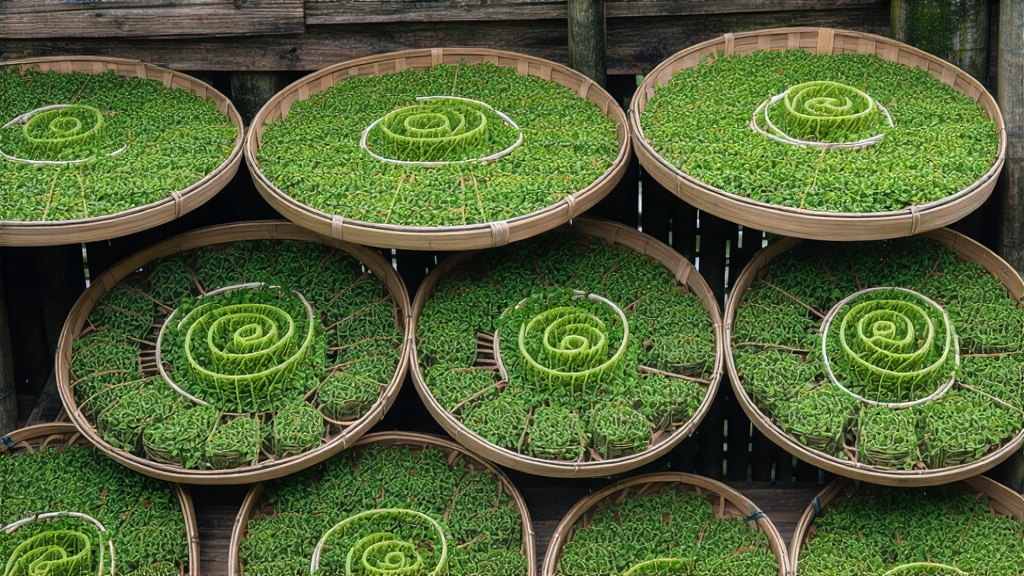
Among the pantheon of Chinese green teas, few names evoke as much poetry and precision as Biluochun. Literally “Green Snail Spring,” this micro-curled, silver-fuzzed leaf is grown on the islands and peninsulas of Taihu Lake in Jiangsu Province, where the same mist that inspired Tang-dynasty painters now nurtures one of the world’s most fragrant teas. To the uninitiated, Biluochun looks like tiny jade snails; to the connoisseur, it is spring itself captured in a cup.
History whispers through every bud. The tea first appears in written record during the late Ming dynasty, when a traveling scholar named Wang Ao noted its “astonishing orchid-ginger perfume” in his 1630 diary. Local legend pushes the origin further back: a tea picker, startled by the sudden reek of a fruit-laden tree, stuffed fresh leaves into her bosom; the warmth of her body and the scent of wild loquat fused, creating an accidental aromatization that farmers later sought to replicate. By the Kangxi era (1662–1722) the leaf had become imperial tribute; the emperor, enchanted by its spiral shape and “curl like a snail,” bestowed the name Biluochun to replace the humbler “Xia Sha Ren Xiang” (“Scary Fragrance”), which locals used to describe its explosive aroma.
Today the appellation is legally protected; only leaf plucked within Dongting East and West Mountains may bear the name. Even within this micro-zone, cultivars differ. The heirloom “Xiao Ye” (“small-leaf”) strain, grown on weather-beaten cliff terraces, yields the most complex cup: a kaleidoscope of peach, watercress, and marine minerality. A newer “Da Ye” (“large-leaf”) clone, planted on gentler slopes, produces a softer, more accessible liquor favored by export blenders. Purists insist that the original Wuniuzao (“Five-Nine-Early”) bush, still propagated by cuttings taken from a single 300-year-old mother plant on Stone Wall Peak, remains the benchmark for top-grade Biluochun.
Crafting Biluochun is a race against dew and time. Picking begins at dawn on the first two weeks of March, when two-leaf-and-a-bud sets measure barely 15 mm. Workers wear white cotton gloves to prevent bruising, and each kilo of finished tea requires 60,000 pluck points—roughly six hours of crouched labor beneath the tea hedges. Within minutes of picking, the fragile shoots are spread on bamboo trays set in shaded breezeways; the goal is to evaporate surface moisture without oxidizing the leaf. Once the edges feel parchment-dry to the touch, the tea enters the kill-green wok, a hand-hammered iron vessel pre-heated to 180 °C. A single craftsman controls temperature with the heel of his palm, tossing the leaf in arcs that last no longer than four minutes. The moment grassy notes give way to toasted soybean, the heat is dropped to 90 °C and the shaping begins.
Shaping is where Biluochun earns its spiral. Using only the pressure of his fingers and the natural sap of the leaf, the master coils each bud into a tight spring, simultaneously rupturing cell walls so that aromatic oils migrate to the surface. The motion is clockwise, always clockwise, echoing the whirlpools of Taihu. After thirty minutes the leaf has lost 70 % of its weight and resembles tiny jade snails; it is then transferred to a charcoal brazier lined with mulberry paper. Here, at 60 °C, the tea slow-dries for another hour, absorbing faint smokiness that acts as a preservative and flavor amplifier. When finished, a single gram contains roughly 120 individual coils, each capable of unfurling like a time-lapse lotus when met with water.
Water itself is the final variable. The classical prescription is “85 °C, glass, 1:50 ratio, triple infusion.” Begin by warming a tall cylindrical glass; the transparency allows appreciation of the “tea dance.” Pour 150 ml of spring water—ideally from the same Dongting springs that feed the lake—then tilt the glass and gently slide three grams of tea down the inner wall. Within seconds the spirals sink, exhaling ribbons of pale jade that smell of white peach and sea spray. The first infusion,